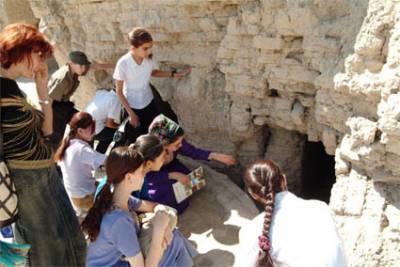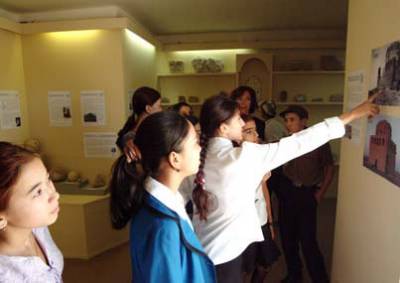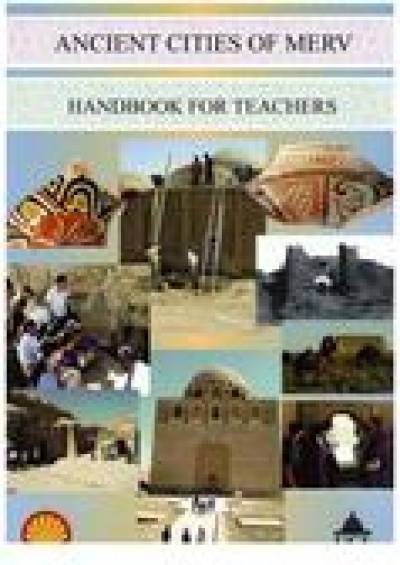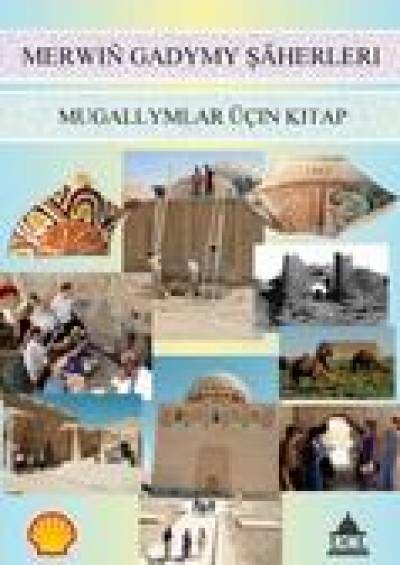Please click on pictures to download Ancient Merv Teacher's Handbook
Teacher's Handbook | Defining the education programme | Producing education resources | Evaluation | Future plans
The Teacher's Handbook provides information on World Heritage Site nominations, and sets the historical background to Ancient Merv by looking at the chronology of Mary, Central Asia and the World, and by focusing on the development of the Silk Routes. A detailed description of the history of the cities of Merv follows, supplemented by information on the need for undertaking archaeological and conservation activities to ensure the survival of Ancient Merv for future generations.

The book provides detailed information to teachers on how it can be used to support evidence-based and life-long learning. On-site educational activities at Ancient Merv can be undertaken, prepared and/or followed up in the classroom by using Resource and Activity sheets. These are developed incrementally over time when research progresses. Both the Teacher's Handbook and the Resource and Activity sheets have been prepared in Turkmen and are currently being distributed in the Merv region.

A Teacher's Handbook has been prepared and discussed with the staff of the Ministry of Culture, the Central Asian Institute, the Merv Archaeological Park and teachers from School No. 4 in Bairam Ali. After consultation, the Teacher's Handbook was printed with a generous grant from Shell. In addition, a short-print run DTP version of the handbook in English, for sponsors circulation and English Language teaching in Turkmenistan , has also been completed.
The Teacher's Handbook is supported by two small on-site museums, which have been prepared in 2004 and 2005. The vision for the future Interpretation Centre includes detailed plans on providing educational resources, interpretation, handling sessions, classrooms and activity spaces in order to ensure high quality education and learning opportunities. Young Turkmen people are the future of this country and increasing the depth of their understanding of the archaeological resource, and the ways in which they value it, is vital for the future of cultural heritage in Turkmenistan.
Defining the education programme
Our broad aims for an education programme at Merv were to
- help local people become better informed about this World Heritage Site, and by extension about their archaeological and historical heritage
- make the public more aware of the problems of conserving their own heritage
- encourage teachers to use Merv in their teaching, not just in history but in other subjects and to use a visit to full advantage
and which involved
- researching the Turkmen education system and curriculum
- finding out whether local schools used the site for formal educational visits
- asking if local families visited the site.
Visiting Merv: There was clear evidence for visits being made to the site at Merv by
- the 300 schools in the local authority district of Mary including the nearest small town of Bairam Ali, with the key times being for 11 year-olds studying 'My Homeland' in history and for 14 year-olds studying the 'History of Turkmenistan' in history. Schools made formal visits which included whole classes and usually spent half a day at the site, in the spring and the autumn
- family groups who came in coaches from all over Turkmenistan to visit this famous site
- local children who often visited in large family groups, mainly to make formal visits to the religious sites and buildings.
Teaching about Merv: Formal meetings with groups of teachers established that
- Pre-visit work dealt with Central Asian historic periods, such as the Achaemenids and the Seljuks, as well as the Silk Roads
- On-site only the main monuments were visited with the teacher talking about each one in turn. No individual or group activity took place
- Post-visit work was an essay by 11 year-olds about what they had seen and what made the biggest impression on them, and a discussion about the visit was conducted in classes of 14 year-olds
- resources were desperately needed, both written and visual, to help teach about Merv
- information about the Silk Roads would be useful as it was part of the curriculum
- the idea of activity and resource sheets for pupils were welcomed although these did not form part of their usual teaching methods
- teachers were interested in information about archaeological methods and the issues of conservation.
Individual teachers eager for new resources and willing to come from the towns and villages around Merv to the ancient site for structured educational visits. They were eager to use an evidence-based approach for their pupils' learning. The Turkmen people are fiercely proud of their heritage. Merv is an iconic site known better than any other historic site in Turkmenistan and considered fundamental to their history.
Producing education resources
On the basis of discussions with teachers draft ideas for teacher resource materials were then prepared. These were tested with a teachers' group in Bairam Ali and with individual teachers in Ashgabat. The results of these discussions were draft materials which were translated into Turkmen and tested on site visits with groups of students and their teachers. After corrections and amendments the final pack was published which consisted of
- An illustrated 36-page colour book for teachers with sections on World Heritage Sites, Timeline, Silk Routes, History of Merv and its monuments, Archaeological techniques, Conservation at Merv and Teaching Strategies covering a number of curriculum subjects
- 12 resource sheets (with material which couldn't be included in the book such as a number of historic photographs) for pupils to use in the classroom and 6 activity sheets for use on site. These were accompanied by notes for teachers suggesting ways in which they might be used and for extension work in cross-curricular subjects.
Subsequently additional activity sheets were produced to add to the pack. All educational resource materials are free. After publication of the book an English-language version was produced (available here) together with the activity and resource sheets. These have proved useful for English-language teachers in Turkmenistan.
Working with teachers/ Evaluation
During and after the publication of the educational resources groups of teachers tested and evaluated the material. Some of this was informal evaluation by receiving comments through the Park staff. Formal evaluation was also carried out with a group of teachers who were asked specific questions about the value and use of the material, with opportunities for their own comments. All comments about the material were positive.
Future plans
The most important areas for the future, if we are to establish a sustainable education programme are:
- To ship copies of the book to Turkmenistan
- To run courses for teachers at Merv to introduce the programme and to provide some in-service training
- To establish a teacher's group based in Bairam Ali to oversee and continue the programme
More Information?
For more information about the teacher's handbook or the educational programmes at Ancient Merv, please contact Mike Corbishley or Gai Jorayev at g.jorayev@ucl.ac.uk
 Close
Close



